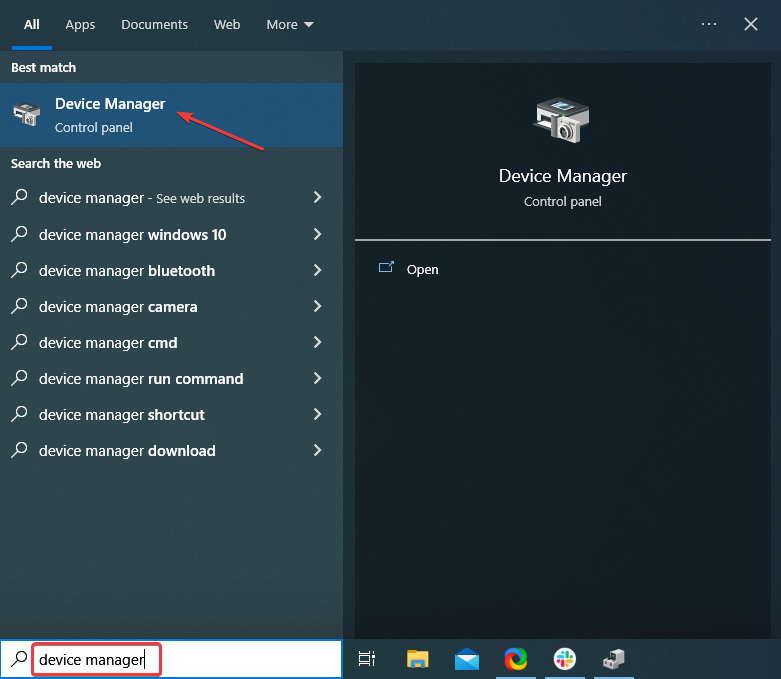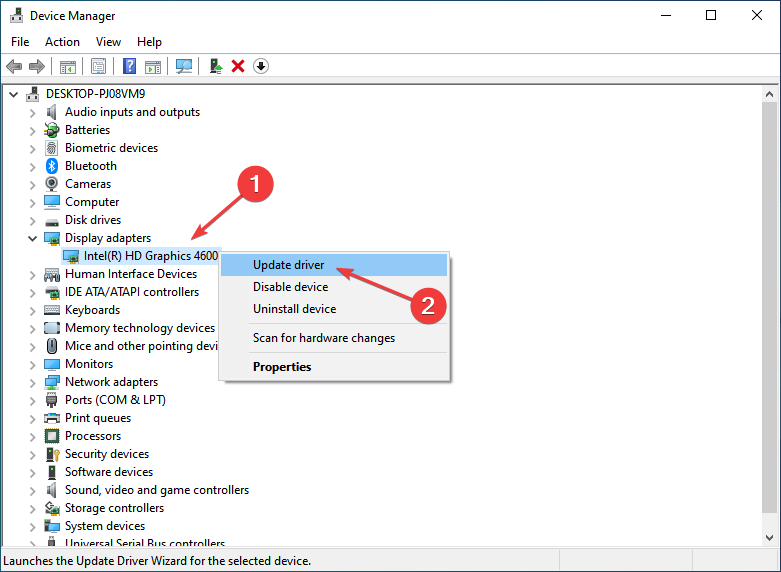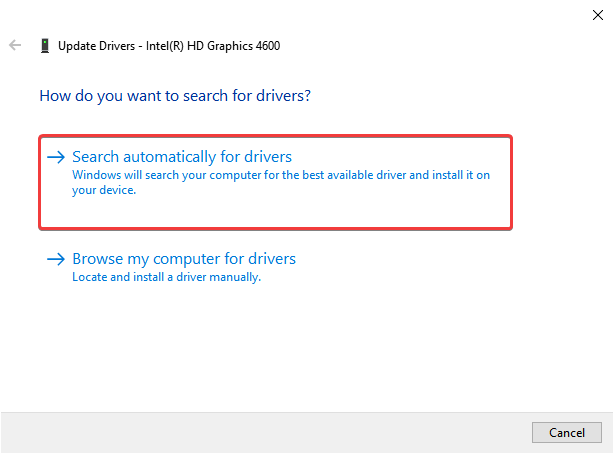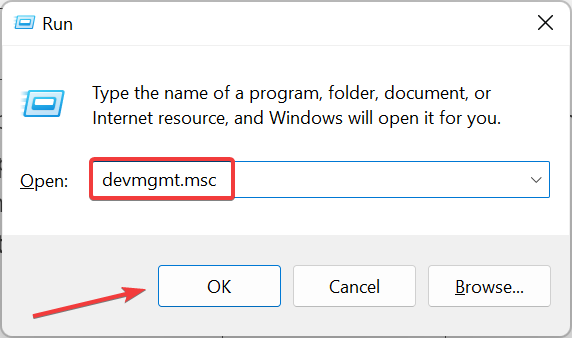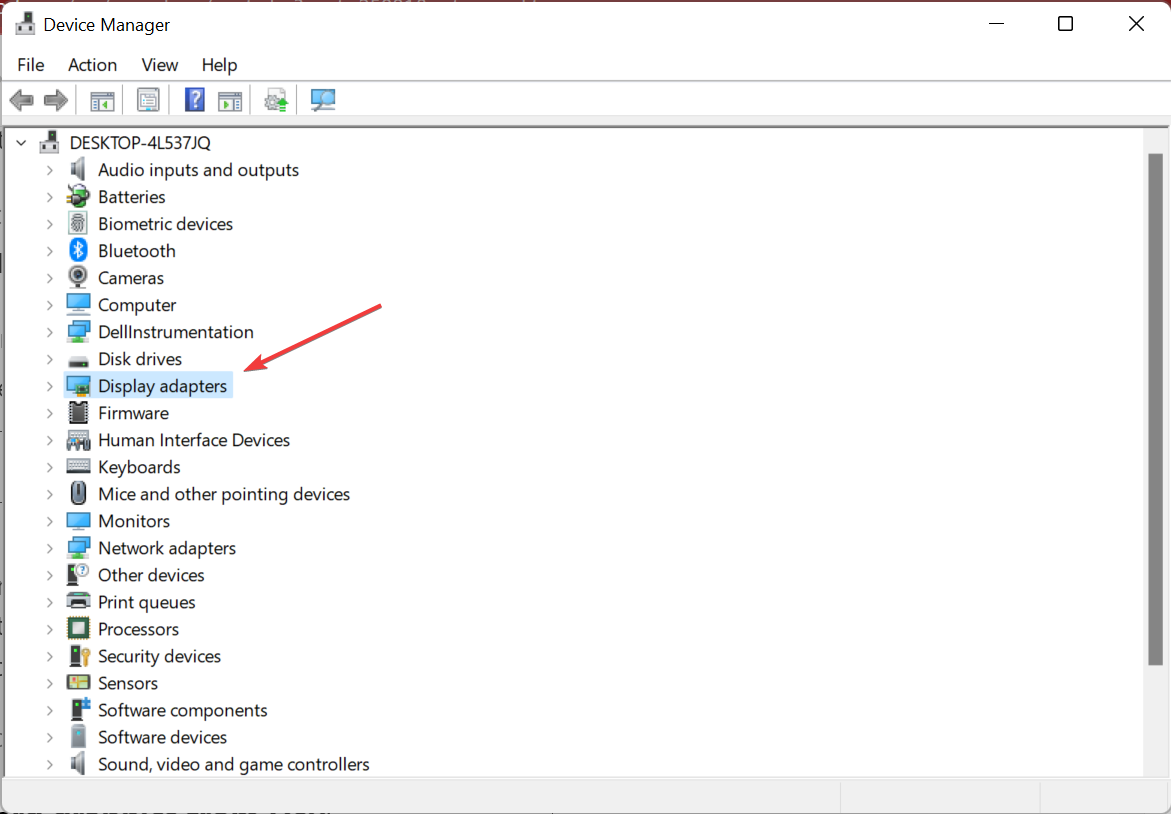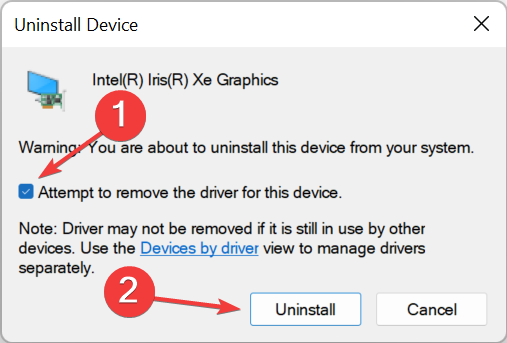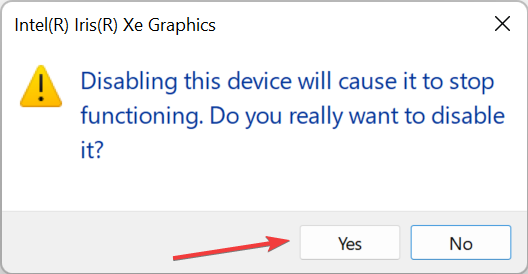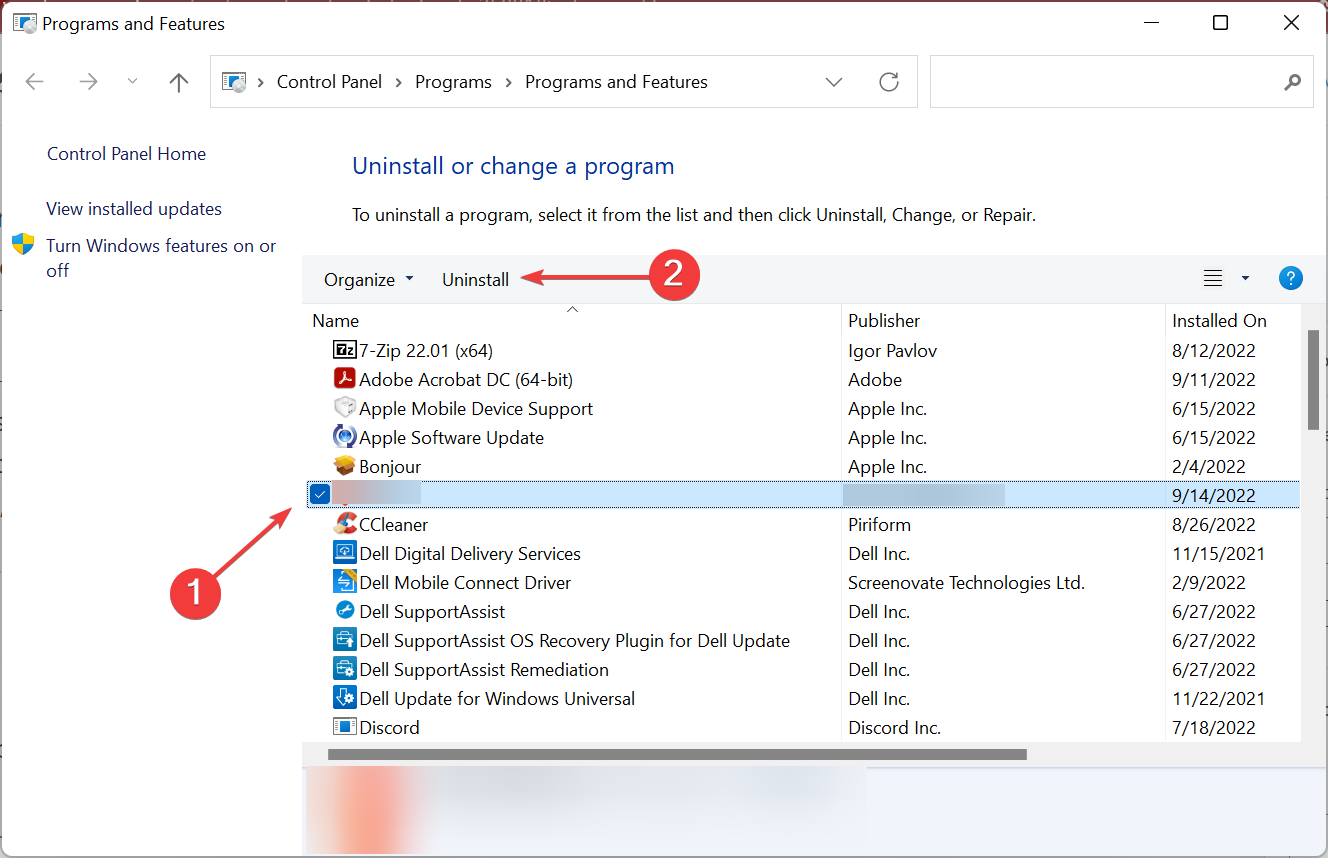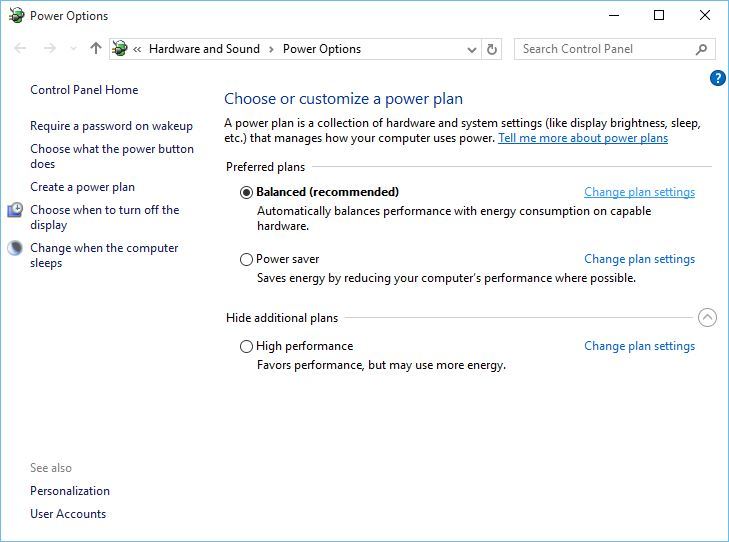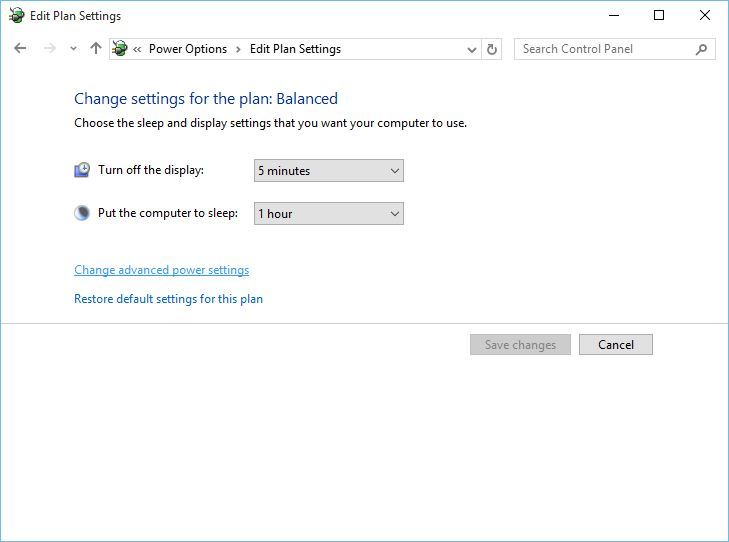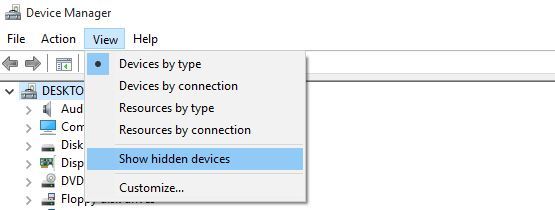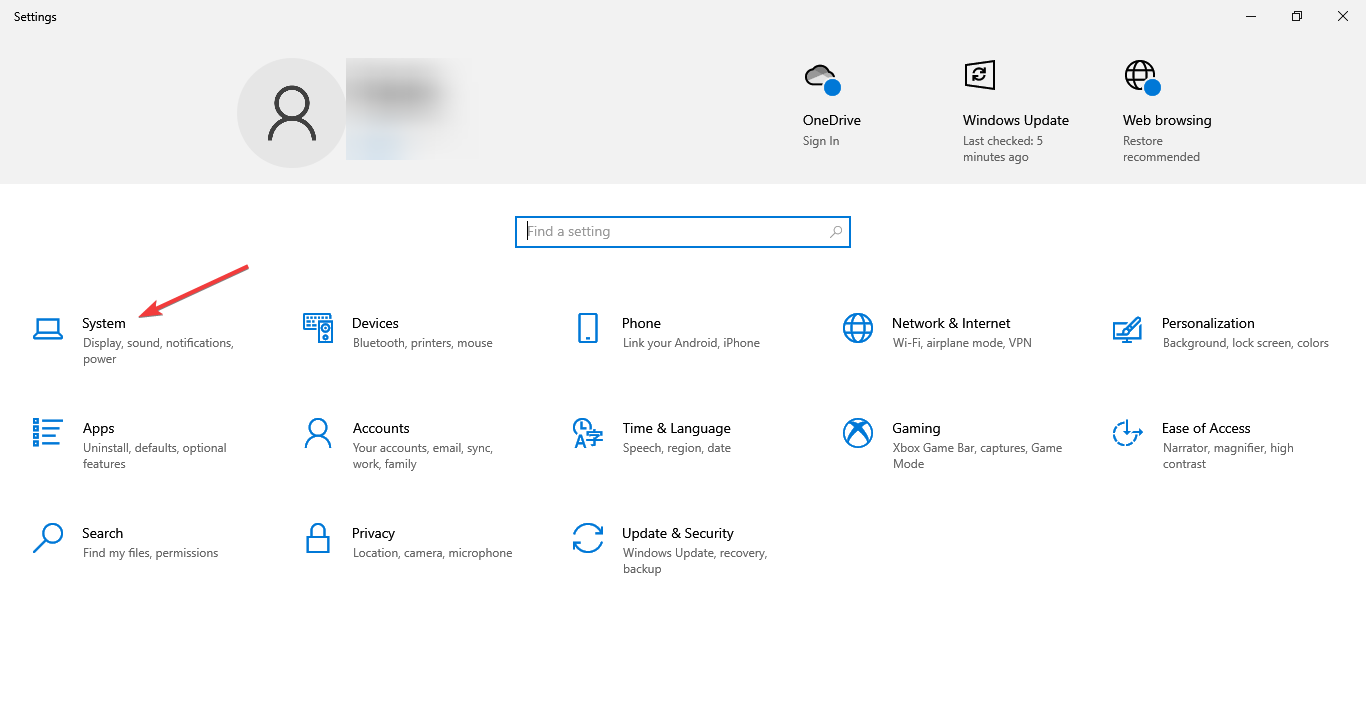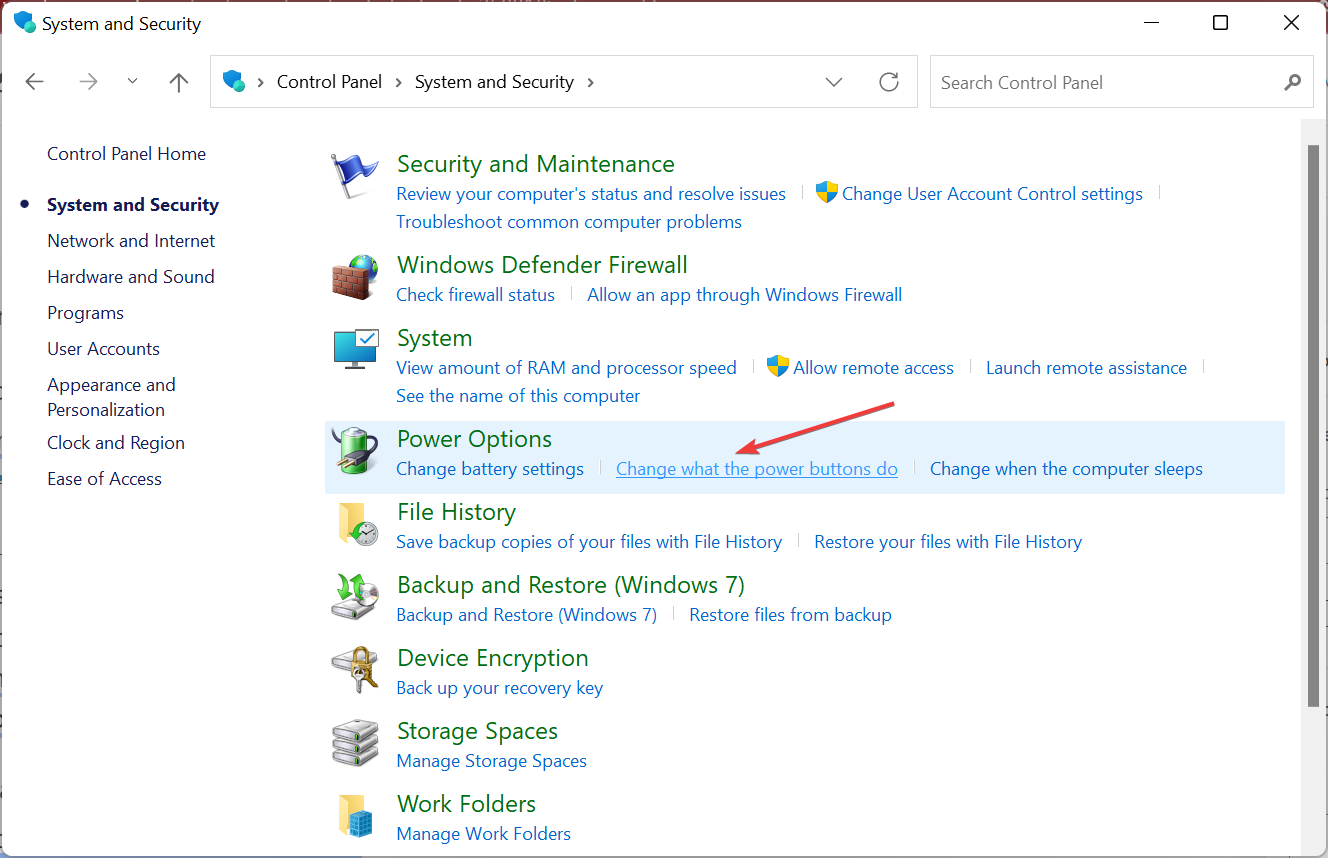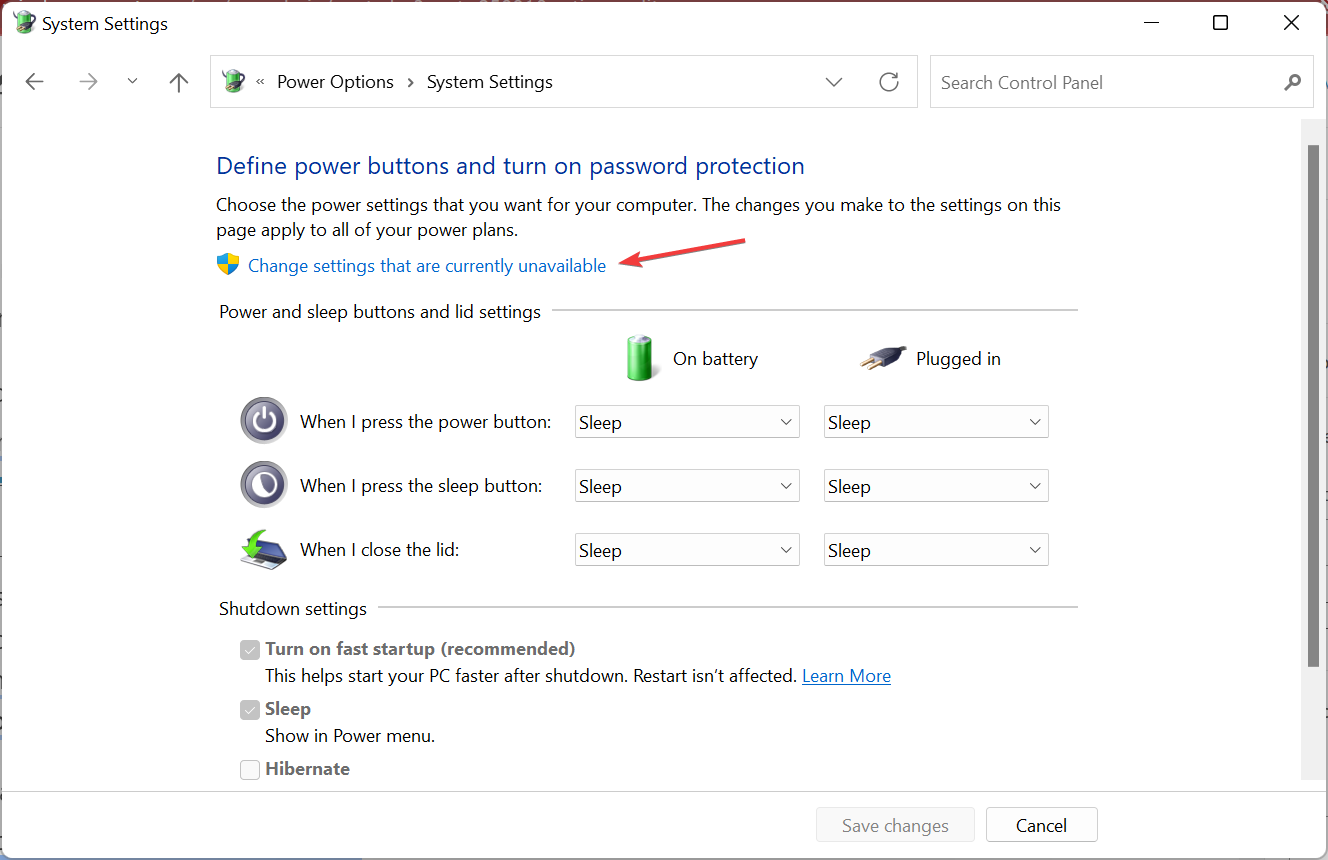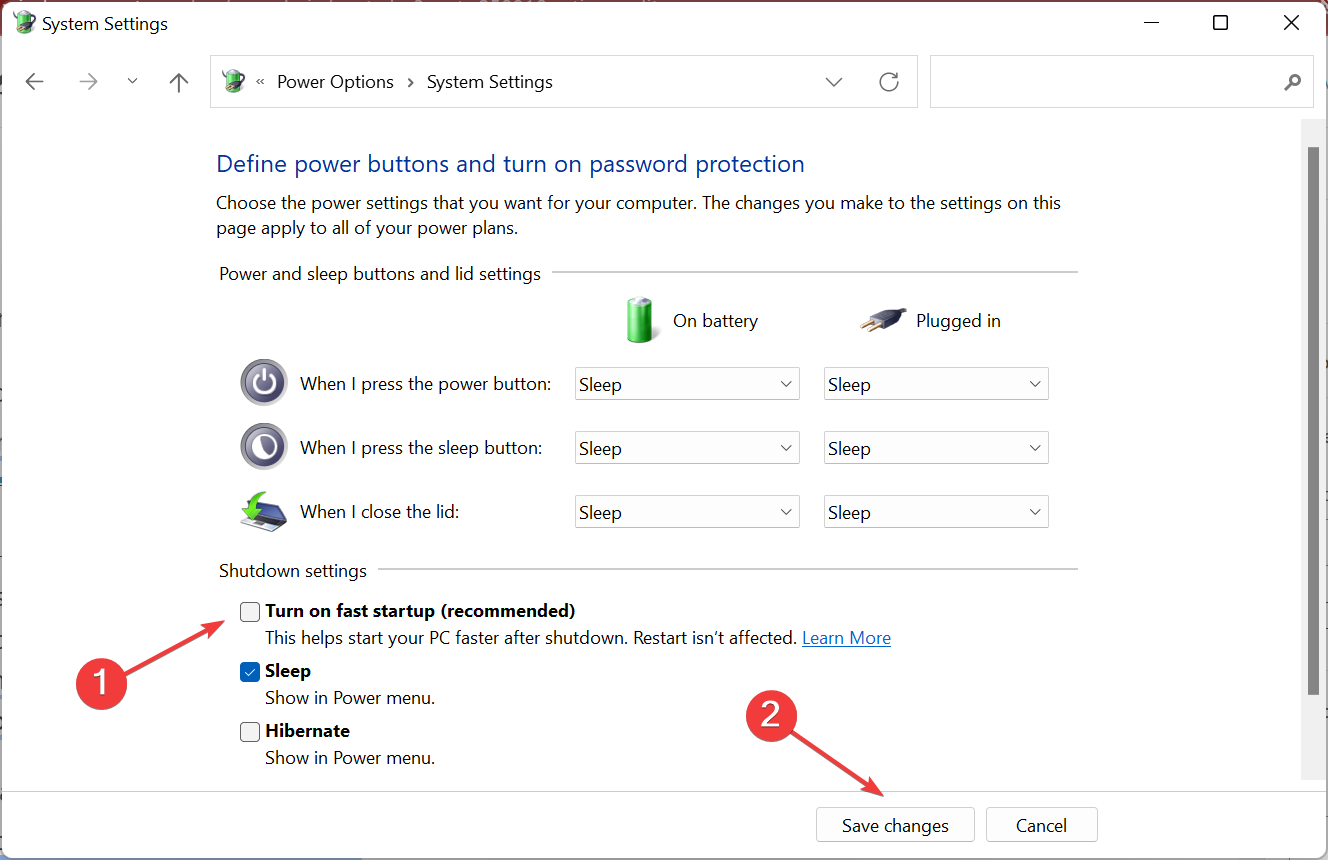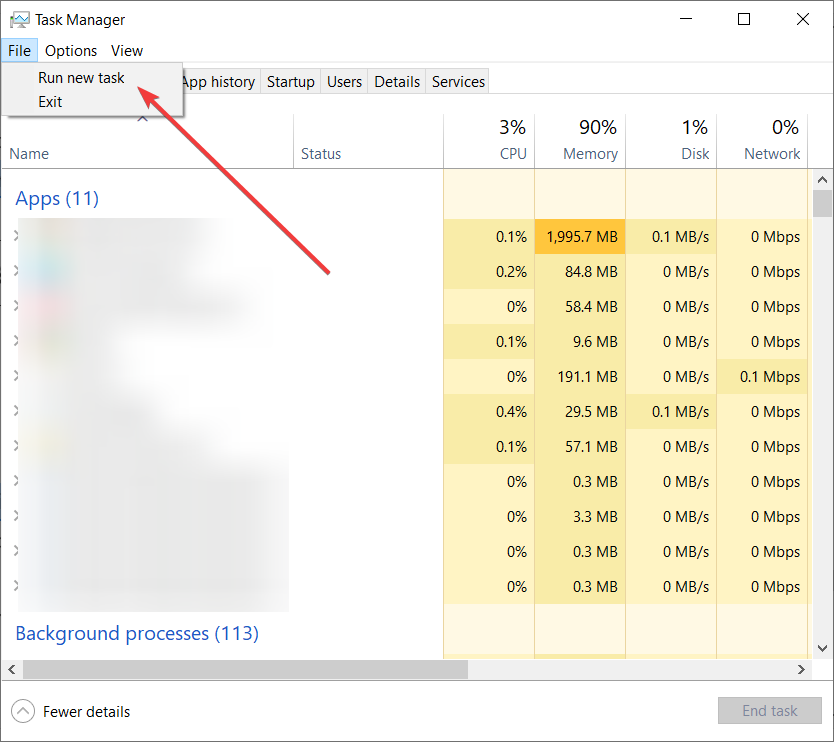Fix Windows 10 Black Screen with Cursor: If you’re facing this issue where your laptop or PC screen suddenly goes black after the startup and you can’t get to the login screen then don’t worry today we are going to see how to fix this issue. When you start your PC, it normally boots and you see Windows 10 login screen, but in this case, you will see the BIOS screen with the Windows logo but after that, all you will see is a black screen with mouse cursor.

The left or right mouse click doesn’t work on the black screen, you will only able to drag the mouse pointer on the black screen which doesn’t have much use. The keyboard also doesn’t respond on the black screen, pressing Ctrl + Alt + Del or Ctrl + Shift + Esc doesn’t do anything, basically, nothing works and you are stuck on the black screen. The only thing which you can do is to force shutdown your PC and turn it off.
There is no particular cause for this issue as it can be caused by corrupted, incompatible or outdated display drivers, corrupted Windows or system files, battery residue etc. If you will try to boot into safe mode then you will get stuck again at the loading files screen and you will again see the black screen with mouse cursor. Anyway, without wasting any time let’s see How to Fix Windows 10 Black Screen with Cursor with the help of the below-listed troubleshooting guide.
Table of Contents
Make sure to create a restore point just in case something goes wrong.
If you are able to login to Windows then try these steps:
To access Windows, you will need to restart your computer in Safe Mode with Network and then follow the below-listed methods.
Method 1: Power Reset your Laptop
The first thing you should try is removing your battery from the laptop and then unplugging all the other USB attachment, power cord etc. Once you have done that then press and hold the power button for 15 seconds and then again insert the battery and try to charge your battery again, see if you are able to Fix Windows 10 Black Screen with Cursor Issue.

Method 2: Switch Displays
1.Press Windows Key + P to open Project menu.
2.Because of the black screen, you won’t be able to see the Project menu, don’t worry that is perfectly normal.
3.You need to press up or down arrow key a few times and hit Enter.
4.If you don’t see your screen and you’re still stuck on the black screen then you may need to repeat the above steps a few times.
Note: If your Windows account is password protected then you will need to press Space bar then enter your password and hit Enter. Once done, then only you will be able to follow the above steps. This can tricky because you will be doing this on a black screen, so you may need to try a few times before you’re successful.
Method 3: Uninstall Your Graphics Card Drivers
1.In Safe Mode press Windows Key + R then type devmgmt.msc and hit enter to open Device Manager.
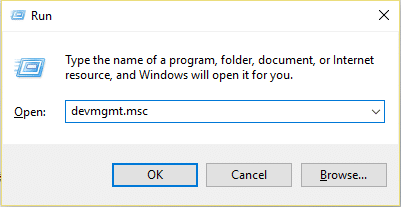
2.Expand Display adapter then right-click on your integrated Display adapter and select uninstall.

3.Now if you have a dedicated Graphics Card then right-click on it and select Disable.

4.Now from the Device Manager menu click Action then click Scan for hardware changes.
5.Reboot your PC and see if you are able to Fix Windows 10 Black Screen with Cursor.
Method 4: Update your Graphics Card Drivers
Manually Update Graphics Drivers using Device Manager
1.Press Windows Key + R then type devmgmt.msc and hit enter to open Device Manager.

2.Next, expand Display adapters and right-click on your Graphics Card and select Enable.
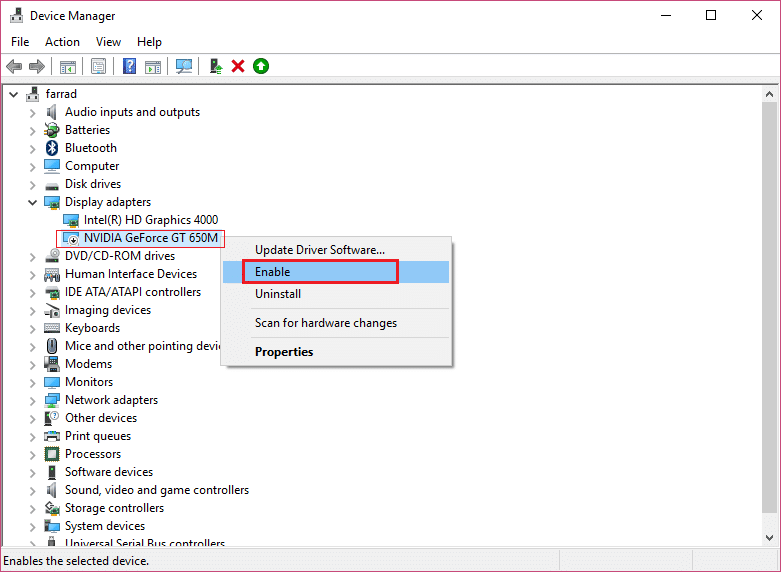
3.Once you have done this again right-click on your graphics card and select “Update Driver“.
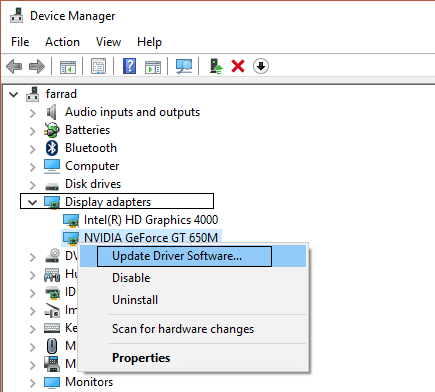
4.Select “Search automatically for updated driver software” and let it finish the process.
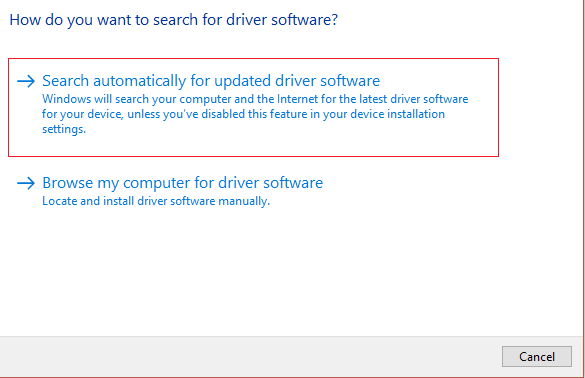
5.If the above steps were helpful in fixing the issue then very good, if not then continue.
6.Again right-click on your graphics card and select “Update Driver” but this time on the next screen select “Browse my computer for driver software.“

7.Now select “Let me pick from a list of available drivers on my computer.”

8.Finally, select the latest driver from the list and click Next.
9.Let the above process finish and restart your PC to save changes.
Follow the same steps for the integrated graphics card (which is Intel in this case) to update its drivers. See if you’re able to Fix Windows 10 Black Screen with Cursor, if not then continue with the next step.
Automatically Update Graphics Drivers from Manufacturer Website
1.Press Windows Key + R and in the dialog box type “dxdiag” and hit enter.
2.After that search for the display tab (there will be two display tabs one for the integrated graphics card and another one will be of Nvidia’s) click on the display tab and find out your graphics card.

3.Now go to the Nvidia driver download website and enter the product details which we just find out.
4.Search your drivers after inputting the information, click Agree and download the drivers.

5.After successful download, install the driver and you have successfully updated your Nvidia drivers manually.
Method 5: Disable Fast Startup
1.Press Windows Key + R then type control and hit Enter to open Control Panel.
2.Click on Hardware and Sound then click on Power Options.

3.Then from the left window pane select “Choose what the power buttons do.“

4.Now click on “Change settings that are currently unavailable.“

5.Uncheck “Turn on fast startup” and click on Save changes.

After the restart see if you’re able to Fix Windows 10 Black Screen with Cursor issue, if not then continue with the next method.
Method 6: Disable Integrated Graphics Card
1.Press Windows Key + R then type devmgmt.msc and hit Enter to open Device Manager.

2.Expand Display adapters then right-click on Intel HD Graphics and select Disable.

3.Reboot your PC to save changes and see if you’re able to Fix Windows 10 Black Screen with Cursor Issue.
Method 7: Activate the built-in Windows Administrator Account
The built-in administrator account is inactive by default and has full unrestricted access to PC. Built-in Administrator Account is a local account and the main difference between this account & the administrator account of the user is that the built-in administrator account doesn’t receive UAC prompts while the other one does. The administrator account of the user is an unelevated administrator account whereas the built-in administrator account is an elevated administrator account. So without wasting any time let’s see How to Enable Built-in Administrator Account.
Method 8: Update your BIOS
Performing a BIOS update is a critical task and if something goes wrong it can seriously damage your system, therefore, expert supervision is recommended.
1.The first step is to identify your BIOS version, to do so press Windows Key + R then type “msinfo32” (without quotes) and hit enter to open System Information.
2.Once the System Information window opens locate BIOS Version/Date then note down the manufacturer and BIOS version.

3.Next, go to your manufacturer’s website for e.g in my case it’s Dell so I will go to Dell website and then I will enter my computer serial number or click on the auto detect option.
4.Now from the list of drivers shown I will click on BIOS and will download the recommended update.
Note: Do not turn off your computer or disconnect from your power source while updating the BIOS or you may harm your computer. During the update, your computer will restart and you will briefly see a black screen.
5.Once the file is downloaded, just double click on the Exe file to run it.
6.Finally, you have updated your BIOS and this may also Fix Windows 10 Black Screen with Cursor.
Method 8: Reset your PC
Note: If you can’t access your PC then restart your PC a few times until you start Automatic Repair. Then navigate to Troubleshoot > Reset this PC > Remove everything.
1.Press Windows Key + I to open Settings then click on Update & Security icon.
2.From the left-hand menu select Recovery.
3.Under Reset this PC click on the “Get Started” button.
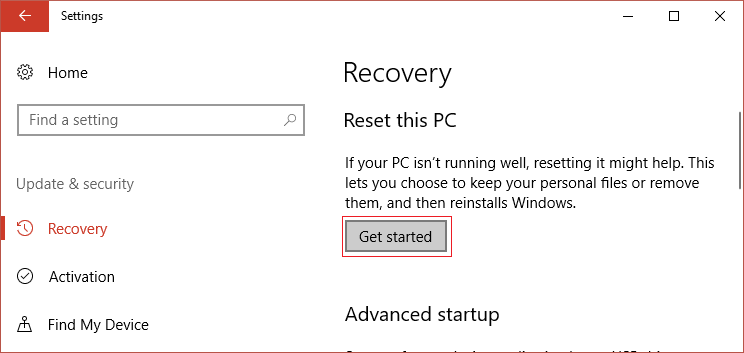
4.Select the option to Keep my files.

5.For the next step, you might be asked to insert Windows 10 installation media.
After the reset or referesh, check if the Windows 10 Black Screen with Cursor issue is reolved or not.
Method 9: Repair Install Windows 10
This method is the last resort because if nothing works out then this method will surely repair all problems with your PC. Repair Install just uses an in-place upgrade to repair issues with the system without deleting user data present on the system. So follow this article to see How to Repair Install Windows 10 Easily.
If you are not able to login to Windows then follow these steps:
Method 1: Run Startup/Automatic Repair
1.Insert the Windows 10 bootable installation DVD and restart your PC.
2.When prompted to Press any key to boot from CD or DVD, press any key to continue.
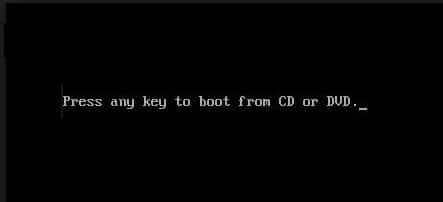
3.Select your language preferences, and click Next. Click Repair your computer in the bottom-left.

4.On choose an option screen, click Troubleshoot.
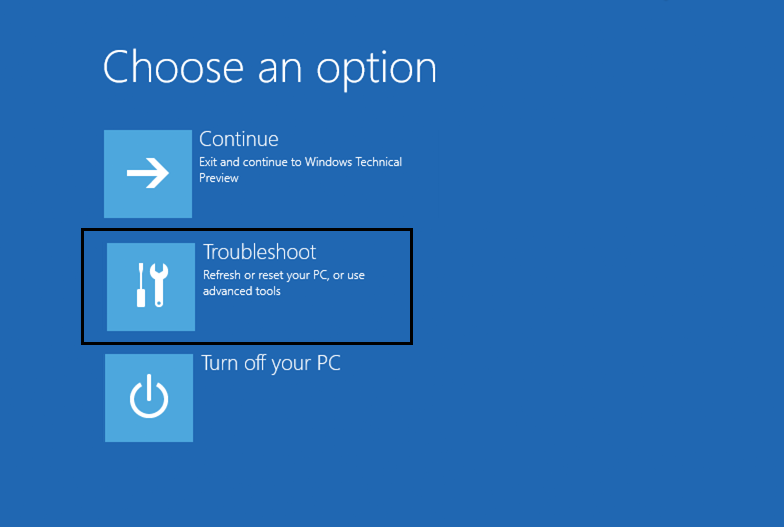
5.On Troubleshoot screen, click Advanced option.
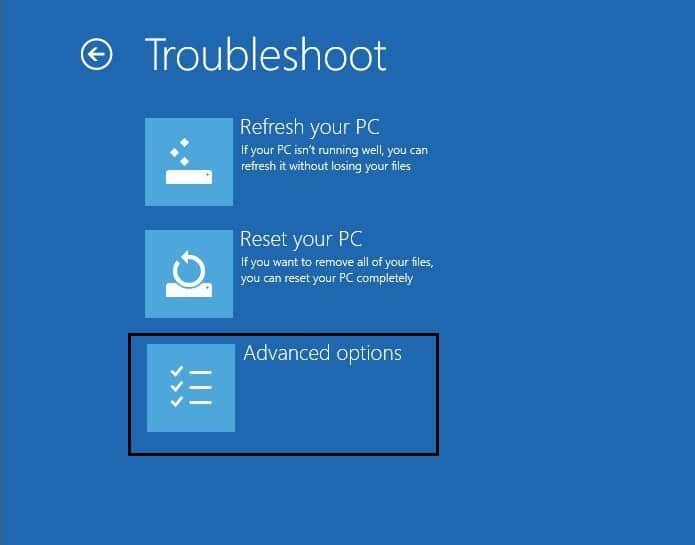
6.On the Advanced options screen, click Automatic Repair or Startup Repair.
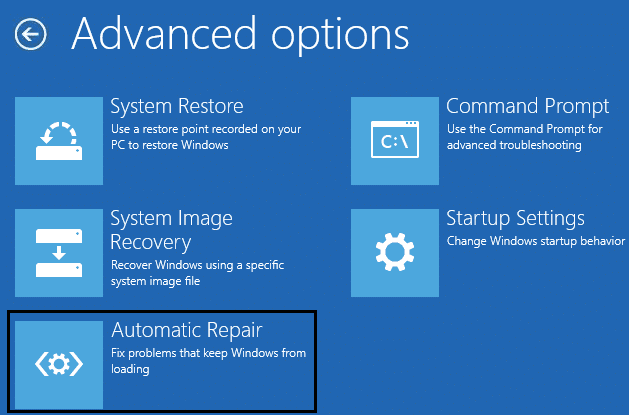
7.Wait till the Windows Automatic/Startup Repairs complete.
8.Restart and you have successfully Fix Windows 10 Black Screen with Cursor Issue.
Also, read How to fix Automatic Repair couldn’t repair your PC.
Method 2: Run System Restore
1.Put in the Windows installation media or Recovery Drive/System Repair Disc and select your language preferences, and click Next
2.Click Repair your computer at the bottom.

3.Now choose Troubleshoot and then Advanced Options.
4..Finally, click on “System Restore” and follow onscreen instructions to complete the restore.

5.Restart your PC to save changes.
Method 3: Run SFC and CHKDSK
1.Using above method open command prompt using Windows installation disk.
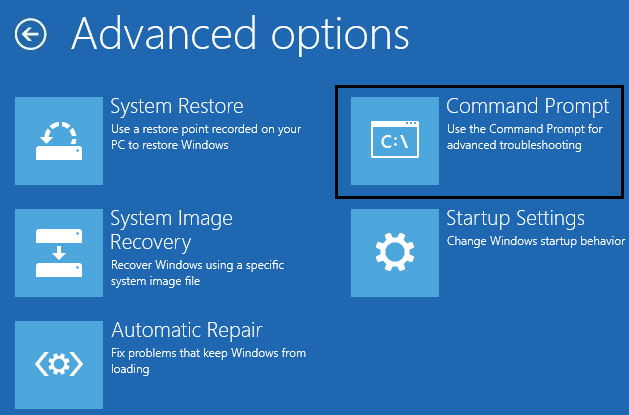
2.Type the following command in cmd and hit enter after each one:
sfc /scannow /offbootdir=c:\ /offwindir=c:\windows chkdsk C: /f /r /x
Note: Make sure you use the drive letter where Windows is currently installed. Also in the above command C: is the drive on which we want to run check disk, /f stands for a flag which chkdsk the permission to fix any errors associated with the drive, /r let chkdsk search for bad sectors and perform recovery and /x instructs the check disk to dismount the drive before beginning the process.

3.Exit the command prompt and restart your PC. This should Fix Windows 10 Black Screen with Cursor Issue but if you’re still stuck then continue with the next method.
Method 4: Run DISM
1.Again open the Command Prompt using the above method and enter the following command:
DISM /Online /Cleanup-Image /RestoreHealth
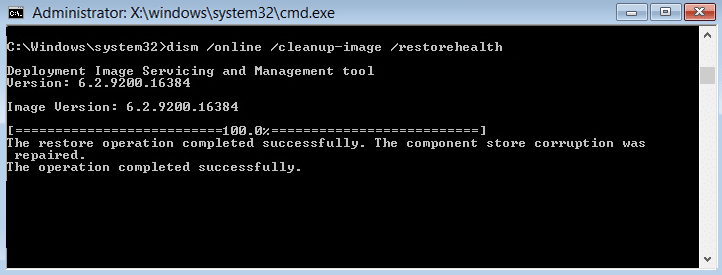
2.Press enter to run the above command and wait for the process to complete, usually, it takes 15-20 minutes.
NOTE: If the above command doesn't work then try on the below: Dism /Image:C:\offline /Cleanup-Image /RestoreHealth /Source:c:\test\mount\windows Dism /Online /Cleanup-Image /RestoreHealth /Source:c:\test\mount\windows /LimitAccess
3.After the process is completed restart your PC.
Method 5: Enable low-resolution video
First of all, make sure to remove all external attachment then remove any CD’s or DVD’s from PC and then reboot.
2.Press and hold the F8 key in order to bring up the advanced boot options screen. For Windows 10 you need to follow this guide.
3.Restart your Windows 10.
4.As the system restarts enter into BIOS setup and configure your PC to boot from CD/DVD.
5.Insert the Windows 10 bootable installation DVD and restart your PC.
6.When prompted to Press any key to boot from CD or DVD, press any key to continue.

7.Select your language preferences, and click Next. Click Repair your computer in the bottom-left.

8.On choose an option screen, click Troubleshoot.

9.On Troubleshoot screen, click Advanced option.

10.On Advanced options screen, click Command Prompt.

11.When the Command Prompt(CMD) open type C: and hit enter.
12.Now type the following command:
BCDEDIT /SET {DEFAULT} BOOTMENUPOLICY LEGACY
13.And hit enter to Enable Legacy Advanced Boot Menu.

14.Close Command Prompt and back on the Choose an option screen, click continue to restart Windows 10.
15.Finally, don’t forget to eject your Windows 10 installation DVD, in order to get Boot options.
16. On the Advanced Boot Options screen, use the arrow keys to highlight Enable low-resolution video (640×480), and then press Enter.

If the issues don’t appear in the low-resolution mode, then the issue is related to Video/Display drivers. You could Fix Windows 10 Black Screen with Cursor issue by simply downloading the display card driver from the manufacturer’s website and installing it via Safe Mode.
Recommended:
- Fix Video TDR Failure (atikmpag.sys) in Windows 10
- Wacom Tablet Error: Your device is not connected to your computer
- Fix Your Windows License Will Expire Soon Error
- Fix Clock Watchdog Timeout Error on Windows 10
That’s it you have successfully Fix Windows 10 Black Screen with Cursor Issue but if you still have any queries regarding this tutorial then feel free to ask them in the comment’s section.
Starting up your PC, seeing the login screen, and then suddenly facing a black screen with only the cursor can be a frustrating experience. No matter how many times you restart, the screen remains black, making it seem like your computer is stuck. Don’t worry—this is a common issue in both Windows 10 and 11, and we’re here to help you solve it.
Here’s a step-by-step guide on how to fix the black screen with a cursor problem, along with some extra methods to try if the first solution doesn’t work.
Key Takeaways
- Uninstalling the latest quality update can often resolve the black screen issue without affecting your files.
- Using the recovery environment and the command prompt are alternative methods to fix the problem.
- If all else fails, resetting your PC might be necessary.
Step 1: Access the Windows Recovery Screen

To start, you’ll need to access the Windows recovery screen. Here’s how:
- Press Ctrl + Alt + Delete on your keyboard. This should bring up a few options.
- In the bottom right corner, click on the power icon.
- Hold down the left Shift key on your keyboard and then click on Restart.
Your computer will now restart and boot into the Windows recovery screen.
Step 2: Uninstall the Latest Quality Update

Once you’re in the recovery environment:
- Click on Troubleshoot.
- Next, select Advanced Options.
- Choose Uninstall Updates.
- You’ll see two options: Uninstall the latest feature update and Uninstall the latest quality update. Choose Uninstall Latest Quality Update.

You will be prompted with a message explaining that this won’t affect your files or apps. Click on Uninstall Quality Update and wait for it to complete. Once done, click on Continue to boot back into Windows.
Prevent Future Issues

After successfully booting into your desktop, consider pausing Windows updates temporarily. This can prevent the same issue from happening again while Microsoft resolves potential bugs. To do this, go to Windows Update and choose to pause updates for a specific time.
Alternative Methods if the First Solution Doesn’t Work
If uninstalling the latest quality update didn’t fix the issue, don’t worry. Here are a couple of other methods you can try.
Method 1: Use the Command Prompt

- Boot into the recovery environment again (follow the steps from Step 1).
- This time, select Command Prompt from the Advanced Options menu.
- Type in the following command and press Enter:
SFC /Scannow
- Wait for the command to finish running, then close the command prompt window.
- Restart your PC.
Method 2: Perform a System Restore

- In the recovery environment, select System Restore from the Advanced Options menu.
- Choose a restore point that was created before the issue started happening.
- Click on Finish to start the restoration process.
- After the restore is completed, select Continue to boot into Windows.
Last Resort: Resetting Your PC

If none of the above methods worked, you might need to reset your PC. Resetting can fix the black screen issue, but it will remove all installed programs and reset your settings. However, you can choose to keep your files. If you need help with this process, check out the following guides:
- How to Reset Windows 10
- How to Reset Windows 11
Conclusion
Facing a black screen with a cursor in Windows 10 or 11 is frustrating, but it’s fixable with the right approach. Whether it’s uninstalling a problematic update or using the command prompt, the methods discussed here should help you get your system back up and running. Remember, if none of these solutions work, resetting your PC might be the only option left.
FAQs
1. Why do I get a black screen with a cursor in Windows 10/11?
This issue is often caused by problematic Windows updates or corrupt system files. Occasionally, a misconfigured graphics driver can also lead to this problem.
2. Will I lose my files if I uninstall the latest quality update?
No, uninstalling the latest quality update will not affect your personal files or installed apps.
3. What should I do if the command prompt method doesn’t work?
If the command prompt method doesn’t fix the issue, try performing a system restore or consider resetting your PC as a last resort.
4. How can I prevent this issue from happening again?
Pausing Windows updates temporarily after resolving the issue can help prevent it from happening again until Microsoft releases a more stable update.
5. Is resetting my PC safe?
Yes, resetting your PC is safe, and you can choose the option to keep your personal files. However, it will remove all installed applications and reset system settings.
Users have reported getting a black screen with a cursor on Windows 10, which appeared at various stages, including while turning on the computer or running an application.
The problem is quite simple and can easily be fixed, but many possible underlying causes make troubleshooting a time-consuming affair.
So, let’s find out why you are encountering Windows 10 black screen with a cursor and its solutions.
You can also watch our video troubleshooting guide below to learn what methods to use to fix black screen issues on Windows 10.
Why am I getting a black screen with a cursor on Windows?
A black screen with a cursor issue usually arises due to connection problems with the display. If the cable is not correctly plugged in at both ends or is damaged, you will likely encounter the issue.
Also, an outdated or corrupt display driver is likely to be an underlying cause. In addition, problems with the display adapter can be a reason behind the issue.
Besides, third-party applications creating conflicts, enabling fast startup, and misconfigured display settings, among other issues, can cause Windows 10 black screen with a cursor.
And the error itself has several variations and won’t appear the same for all. Here are a few of these:
- Windows 10 black screen with cursor, where Ctrl + Alt + Del doesn’t work
- Black screen with cursor and no Task Manager in Windows 10
- Windows 10 black screen with cursor and Start menu
Tip
After solving this issue, we strongly recommend that you use Outbyte Driver Updater to keep your system updated at all times. This software will prevent it from appearing in the future by constantly updating your drivers, thus increasing your computer’s health.
How do I fix the Windows 10 black screen with cursor error?
NOTE
The first ten solutions here are aimed at getting the computer in a working connection, i.e., getting rid of the black screen, and the ones that follow will eliminate the root cause. So, make sure to try them all.
1. Check the connections
The first thing you have to do when fixing Windows 10 black screen with the cursor issue is to identify and rectify any connection issues. Then, check the cable for damages, and unplug and replug it after blowing light air into the ports. And make sure you are using a compatible one.
Also, if you have a spare cable, use it to verify whether the problem lies with the other one you have been using. If nothing works, it’s not the connections behind the issue. So, head to the next solution.
2. Change projections to switch displays
- Press Windows + P shortcut to open the Project menu.
- The project menu will now open, but you won’t be able to see it. Don’t worry, that’s perfectly normal.
- Now press the Up or Down arrow keys a few times and press Enter.
- If you are successful, the screen should appear. However, in the problem persists, you might have to repeat this step a few times.
If you’re getting a black screen with a cursor in Windows 10, you might want to try changing the projection mode.
After updating to Windows 10, your project mode might change to Second screen only, and you need to change that by following our instructions.
We’ve had this issue, and it was fixed after 6 or 7 tries, so you must be persistent.
If you get the Windows black screen with a cursor before login and your account is protected by a password, you’ll have to log in first. To do this, press Space or Ctrl, enter your password, and Enter.
This can be tricky because you’ll be doing this on a black screen so that it might take you a few tries.
3. Connect your monitor with both cables to the monitor
This is an unusual solution, but users have reported that it fixes the black screen before the login problem.
According to users, if you have a monitor with two connectors, such as DVI and HDMI, you need to connect your monitor using both DVI and HDMI cables.
After that, you can turn on your computer and check if the problem is resolved.
Some users also suggest that you might be able to fix this issue by attaching an additional monitor, so if you have an extra monitor, try connecting it to your PC.
Even if this doesn’t fix the problem, your second monitor should work without any issues.
4. Update your BIOS
Some users claim you can fix the black screen with the cursor by updating your BIOS.
Updating BIOS is a procedure for advanced users, and if you don’t do it properly, it can cause permanent damage to your hardware, so please keep that in mind.
To perform a BIOS update, you need to go to your motherboard manufacturer’s website and download the latest version of BIOS for your motherboard.
In most cases, there should be an instruction manual on updating the BIOS, so make sure you read it carefully. If you don’t know how to update your BIOS, please ask an expert to do it for you to avoid any potential damage.
5. Disable Dual monitor from BIOS/disable CPU Graphics Multi-Monitor
- While your computer boots, press F2 or Del (it might be a different key on your computer) to access BIOS.
- You need to find and disable CPU graphics or Dual monitor functions.
- Save changes and restart your PC.
6. Update your drivers
- Type Device Manager in the Search bar, then click on the relevant search result.
- Now, expand the Display adapter section.
- Right-click on your graphics device and select Update Driver.
- Select the Search automatically for drivers option.
- Windows will now search for any pending update and download it.
- Once the update is installed, check if Windows 10 fit the screen.
Updating drivers manually is a serious procedure that can be a bit time-consuming, and it does not assure you that the system will find the latest drivers.
You can update your drivers by using a unique third-party software tool. We recommend using dedicated software because it can automate the task almost entirely, saving time and hassle.
Most common Windows errors and bugs can result from faulty or incompatible drivers. An outdated system can lead to lags, system issues, or even BSoDs.
You can prevent these problems by using an automatic tool that will search and install the correct drivers on your computer with just a few clicks. That’s why we recommend you use Outbyte Driver Updater.
Here’s how to do it:
- Download and install the Outbyte Driver Updater app.
- Launch the software.
- Wait for the app to detect all incompatible drivers.
- Afterward, it will show you a list of the drivers found to select the ones to Update or Ignore.
- Click on Update & Apply Selected to download and install the newest versions.
- Restart your PC to ensure the applied changes.
Outbyte Driver Updater
Use this software and solve all driver-related issues from your PC.
Disclaimer: You may need to upgrade the app from the free version to perform specific actions.
7. Disconnect your second monitor
In some instances,the black screen with cursor error on Windows 10 can be fixed by unplugging your second monitor.
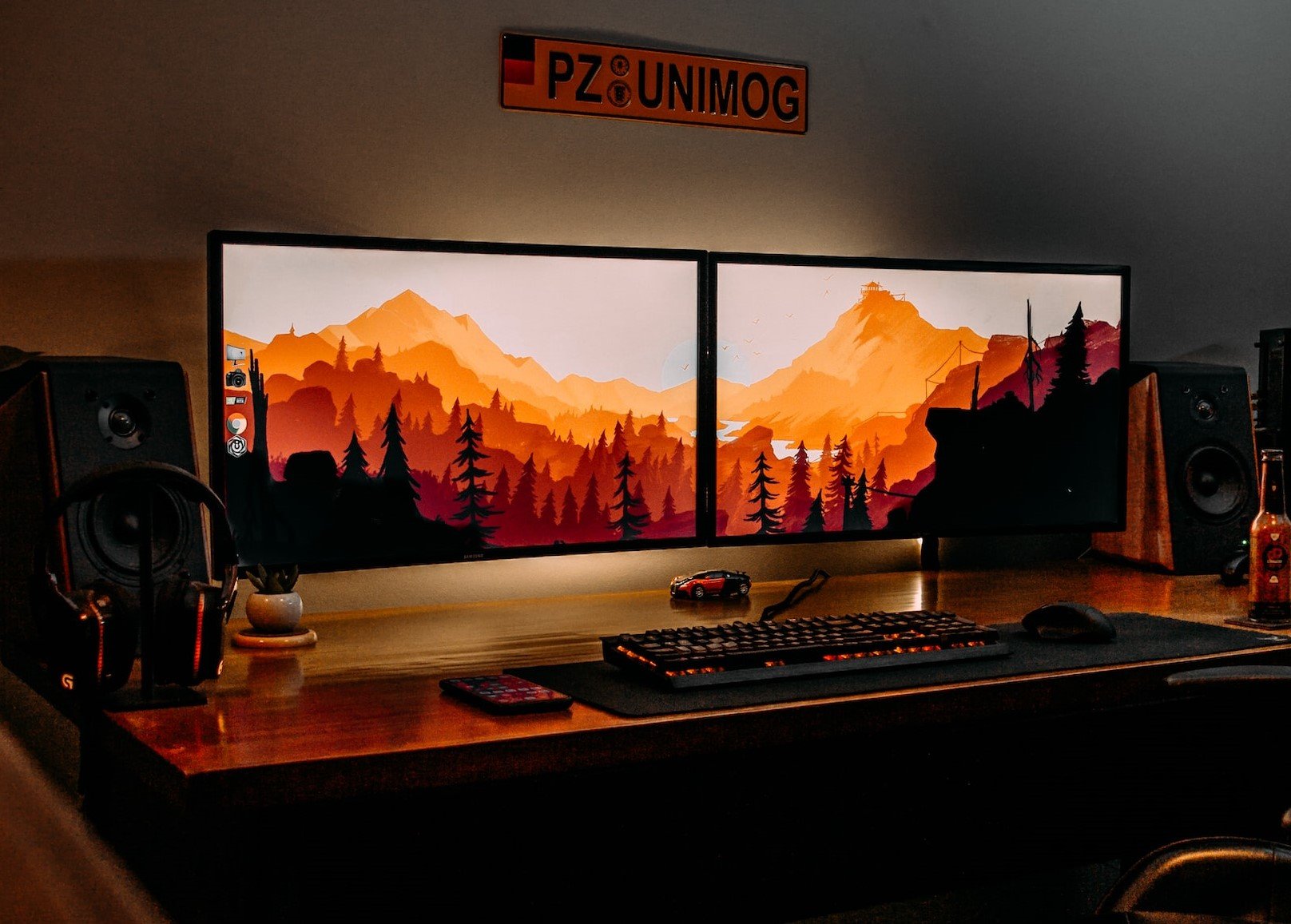
Nvidia users have reported that unplugging the second monitor fixed this issue for them, so make sure you try it out.
8. Set display output to IGFX
- While your computer boots, keep pressing F2, F4, or Del to access BIOS.
- Locate the Display output setting, and set it to IGFX. This will make your integrated graphics the first display.
- Save changes and exit.
9. Check your graphic card settings in BIOS
Enter BIOS and ensure your graphic card is set to use the PCI-E slot. Sometimes this setting might get changed to PCI, and if that’s the case, switch it to the PCI-E option and save the changes.
This effective solution has worked for many, and we recommend giving it a try.
10. Remove the computer battery and reset your BIOS
If other solutions don’t work, you might want to remove your computer’s battery and reset your BIOS. When you do this, the computer’s warranty will be terminated immediately, so keep that in mind.

If you don’t know how to do this properly, maybe it’s best to hire an expert to do it for you.
11. Check additional displays
Make sure you don’t have other displays such as monitors or TV connected to your HDMI port.
If you have a device connected to the HDMI port, Windows 10 might use it as the primary display during the installation, so before you start your building, make sure you’re using only one display.
In addition, you can always connect your monitor using the HDMI cable to fix this problem, or you can disconnect the other display.
By now, we expect that you have managed to get rid of the black screen with cursor in Windows 10 and have your PC up and running. But the root cause may still be present, so you must try the solutions listed below to eliminate the issue completely.
If the problem remains, boot your PC into Safe Mode and execute the following methods.
12. Uninstall your graphic card driver
- Press Windows + R to open Run, enter devmgmt.msc in the text field, and click OK.
- Double-click on the Display adapters entry here.
- Right-click on the graphics card, and then select Uninstall device.
- Tick the checkbox for Attempt to remove the driver for this device and click on Uninstall.
If the problem lies with the graphics adapter, uninstalling the device will make Windows revert to the generic ones. Though the performance wouldn’t be as good, you will undoubtedly encounter fewer issues and will be able to fix Windows 10 black screen with a cursor.
Once you find the right driver for the graphics adapter, install it.
13. Disable onboard graphics from Device Manager
- Launch Device Manager, locate the onboard graphics, right-click on it, and select Disable device.
- Click Yes in the confirmation prompt that appears.
If your computer has both onboard and dedicated graphics, make sure you disable your onboard graphic from Device Manager to fix the black screen with cursor in Windows 10.
14. Uninstall problematic applications
- Press Windows + R to open Run, enter appwiz.cpl in the text field, and click OK.
- Select the program you want to remove, and click on Uninstall.
- Now, follow the on-screen instructions to complete the process.
If you are facing a black screen with cursor in Windows 10, certain applications such as antivirus, third-party firewall, iCloud, Cisco VPN client, or IDT Audio can cause this problem.
To fix this problem, it’s advised that you uninstall those applications from your PC.
However, you can also count on third-party uninstaller software that removes problematic applications and automatically cleans up leftovers from your device, even those left behind by other software.
15. Change display brightness
- Press Windows + S to open the Search menu, type Power Options, and click on the relevant search result.
- Find your current plan, and click Change plan settings.
- Now click on Change advanced power settings.
- Locate the Display brightness setting and set it to 99% or 98% when your device is plugged in.
- Save changes and restart your PC.
Users have reported a black screen on Windows 10 after they connect the AC adapter to their laptops. In most cases, the computer works fine, but the screen goes dark after the user connects the AC adapter.
This is caused by the display brightness problem and can easily be fixed with this solution. Find out what to do if you are unable to change the display brightness.
16. Disable the secondary output
- Press Windows + X and select Device Manager from the list of options.
- Click View, and select Show hidden devices.
- Locate Secondary Output, right-click it and choose Disable.
- Confirm the action and then restart your PC.
- Now, check if the issue is resolved.
If you have a black screen with a cursor problem in Windows 10, this can happen if you use two or more monitors on your PC. And the simplest solution is to disable all the secondary devices.
17. Change primary display
- Press Windows + I to open Settings, and then choose System.
- In the Display section, you should see several displays available. Select the display you wish to use as the main one and click Make this my main display.
- Click Apply to save changes.
If you have problems with a black screen with a cursor before login in on Windows 10, you might want to try connecting your monitor to your PC with an HDMI cable.
Users have reported that you can use an HDMI connection instead of DVI, which will fix black screen issues.
If you connect both HDMI and DVI cables, your PC might see the DVI connection as the second monitor (even if you have only one monitor), and if that’s the case, you need to set your main display.
18. Disable/enable dedicated card from BIOS
Some users have reported that enabling or disabling dedicated graphics fixes this issue for them. To do that, you need to enter BIOS and locate Graphic settings.
Now choose between Switchable or Discreet options, depending on which one you want to use. Choose the Discreet option for example, if you enable a dedicated graphic card.
19. Disable Fast Startup
- Press Windows + R to open Run, enter Control Panel in the text field, and click OK.
- Click on System and Security.
- Now, click on the Change what the powers buttons do.
- Click on Change settings that are currently unavailable.
- Untick the checkbox for Turn on fast startup (recommended) and click on Save changes.
In some cases, Fast Startup may trigger the black screen with a cursor issue in Windows 10. In this case, you can quickly fix this problem by simply disabling this option.
20. Connect your monitor to an integrated graphic card
In certain situations, Windows 10 might not recognize your dedicated graphic card. So the only solution is to connect your monitor directly to your integrated graphic card.
After that, the black screen with the cursor problem in Windows 10 will be fixed.
Using your integrated graphics card is not such a big deal. Still, if you need more power and don’t want to use the dedicated card, you can increase the VRAM on the integrated one.
21. Uninstall problematic software before the upgrade
If you’re planning to upgrade to Windows 10, you might experience a black screen with a cursor problem during installation if you don’t delete specific programs.
Sometimes your antivirus or firewall can cause this problem during the installation, so you might want to remove them temporarily.
In addition, if you use any tools that change the looks of your Windows, such as OldNewExplorer or ClassicShell, you should uninstall them before upgrading to Windows 10.
22. Start File Explorer with administrative privileges
- Press Ctrl + Shift + Esc to open the Task Manager, click on the File menu at the top-left corner and select Run new task.
- Enter explorer.exe in the text field, check the Create this task with administrative privileges box, and then click OK.
As bizarre as it may seem, some users fixed the issue by starting File Explorer with administrative privileges, so you might as well try that too.
How do I fix Windows 11 black screen with cursor?
Black screen with cursor in Windows 11 is encountered for more or less the same reasons as Windows 10, and the solutions, too, remain the same.
Whenever you encounter the issue, the primary approach should be to verify that the connections are in order and that the connected devices are all compatible.
Once you are sure of these, move to the software-based solutions, for instance, updating the driver, uninstalling conflicting applications, or disabling fast startup, among others.
Some users also reported Windows 11 black screen with cursor and no Task Manager, and the solutions remain the same.
As you can see, the black screen with a cursor on Windows 10 can create many problems. But in most cases, you can fix it by disconnecting additional monitors or connecting it to a different port.
Also, find out what to do if you get a black screen after sleep in Windows 10 since many users have been facing the problem.
Tell us if our solutions have helped you solve this annoying problem by referring to the comment section below.
Если после обновления или установки Windows 10, а также после перезагрузки уже успешно установленной системы вас встречает черный экран с указателем мыши (а возможно, и без него), в статье ниже я расскажу о возможных способах исправить проблему, не прибегая к переустановке системы.
Проблема обычно связана с неправильной работой драйверов видеокарт NVidia и AMD Radeon, однако это не единственная причина. В рамках этой инструкции будет рассматриваться тот случай (наиболее распространенный в последнее время), когда, судя по всем признакам (звуки, работа компьютера), Windows 10 загружается, однако на экране ничего не отображается (кроме, возможно, указателя мыши), также возможен вариант, когда черный экран появляется после сна или гибернации (или после выключения и повторного включения компьютера). Дополнительные варианты этой проблемы в инструкции Не запускается Windows 10. Для начала несколько быстрых способов решения для распространенных ситуаций.
- Если при последнем выключении Windows 10 вы видели сообщение Подождите, не выключайте компьютер (идет установка обновлений), а при включении видите черный экран — просто подождите, иногда так устанавливаются обновления, это может занять вплоть до получаса, особенно на медленных ноутбуках (Еще один признак того, что дело именно в этом — высокая нагрузка на процессор, вызываемая Windows Modules Installer Worker).
- В некоторых случаях проблема может быть вызвана подключенным вторым монитором. В этом случае попробуйте его отключить, а если это не сработало, то зайти в систему вслепую (описано ниже, в разделе про перезагрузку), после чего нажать клавиши Windows+P (английская), один раз клавишу вниз и Enter.
- Если вы видите экран входа, а после входа появляется черный экран, то попробуйте следующий вариант. На экране входа нажмите по кнопке вкл-выкл справа внизу, а затем, удерживая Shift, нажмите «Перезагрузка». В открывшемся меню выберите Диагностика — Дополнительные параметры — Восстановление системы.
Если вы столкнулись с описываемой проблемой после удаления какого-либо вируса с компьютера, а на экране видите указатель мыши, то вам с большей вероятностью поможет следующее руководство: Не загружается рабочий стол — что делать. Есть еще один вариант: если проблема появилась после изменения структуры разделов на жестком диске или после повреждений HDD, то черный экран сразу после логотипа загрузки, без всяких звуков может быть признаком недоступности тома с системой. Подробнее: Ошибка Inaccessible_boot_device в Windows 10 (см. раздел про изменившуюся структуру разделов, несмотря на то, что текст ошибки у вас не показывается, это может быть ваш случай).
Перезагрузка Windows 10
Один из работающих способов исправить проблему с черным экраном после повторного включения Windows 10, судя по всему, вполне работоспособный для владельцев видеокарт AMD (ATI) Radeon — полностью перезагрузить компьютер, после чего отключить быстрый запуск Windows 10.
Для того, чтобы сделать это вслепую (будет описано два способа), после загрузки компьютера с черным экраном несколько раз нажмите на клавишу Backspace (стрелка влево для удаления символа) — это уберет заставку экрана блокировки и удалит любые символы из поля ввода пароля, если вы их туда случайно ввели.
После этого, переключите раскладку клавиатуры (если требуется, по умолчанию в Windows 10 обычно русский, переключить почти гарантированно можно клавишами Windows + Пробел) и введите свой пароль учетной записи. Нажмите Enter и подождите, пока система загрузится.
Следующий шаг — перезагрузка компьютера. Для этого, нажмите на клавиатуре клавиши Windows (клавиша с эмблемой) + R, подождите 5-10 секунд, введите (опять же, может потребоваться переключить раскладку клавиатуры, если по умолчанию в системе у вас русский): shutdown /r и нажмите Enter. Через несколько секунд еще раз нажмите Enter и подождите около минуты, компьютер должен будет перезагрузиться — вполне возможно, в этот раз вы увидите изображение на экране.
Второй способ перезагрузки Windows 10 при черном экране — после включения компьютера несколько раз нажать клавишу Backspace (а можно пробел или любой символ), затем — пять раз нажать клавишу Tab (это переведет нас к иконке включения-выключения на экране блокировки), нажать Enter, затем — клавишу «Вверх» и еще раз Enter. После этого компьютер перезагрузится.
Если ни один из этих вариантов не позволяет перезагрузить компьютер, вы можете попробовать (потенциально опасно) принудительное выключение компьютера долгим удерживанием кнопки питания. А затем снова включить его.
Если в результате вышеописанного изображение на экране появилось, значит дело именно в работе драйверов видеокарты после быстрого запуска (который по умолчанию используется в Windows 10) и для исключения повторения ошибки.
Отключение быстрого запуска Windows 10:
- Кликните правой кнопкой мыши по кнопке Пуск, выберите Панель управления, а в ней — Электропитание.
- Слева выберите «Действия кнопок питания».
- Вверху нажмите «Изменение параметров, которые сейчас недоступны».
- Пролистайте окно вниз и снимите отметку с пункта «Включить быстрый запуск».
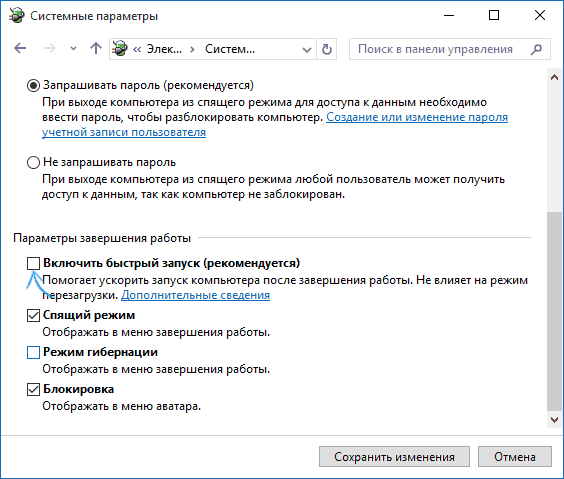
Сохраните сделанные изменения. Проблема в дальнейшем повториться не должна.
Использование интегрированного видео
Если у вас имеется выход для подключения монитора не от дискретной видеокарты, а на материнской плате, попробуйте выключить компьютер, подключить монитор к данному выходу и снова включить компьютер.
Есть немалая вероятность (если интегрированный адаптер не отключен в UEFI), что после включения, вы увидите изображение на экране и сможете выполнить откат драйверов дискретной видеокарты (через диспетчер устройств), установить новые или же использовать восстановление системы.
Удаление и переустановка драйверов видеокарты
Если предыдущий способ не сработал, следует попробовать удалить драйвера видеокарты из Windows 10. Сделать это можно в безопасном режиме или в режиме с низким разрешением экрана, а о том, как в него попасть, видя только черный экран, я сейчас расскажу (два способа для разных ситуаций).
Первый вариант. На экране входа (черном) несколько раз нажмите Backspace, затем — 5 раз Tab, нажмите Enter, потом — один раз вверх и, удерживая Shift, снова Enter. Подождите около минуты (загрузится меню диагностики, восстановления, отката системы, которое вы, вероятно, тоже не увидите).
Следующие шаги:
- Три раза вниз – Enter — два раза вниз — Enter – два раза влево.
- Для компьютеров с BIOS и MBR — один раз вниз, Enter. Для компьютеров с UEFI — два раза вниз – Enter. Если вы не знаете, какой у вас вариант — нажмите «вниз» один раз, а если попадете в настройки UEFI (BIOS), то используйте вариант с двумя нажатиями.
- Еще раз нажмите Enter.
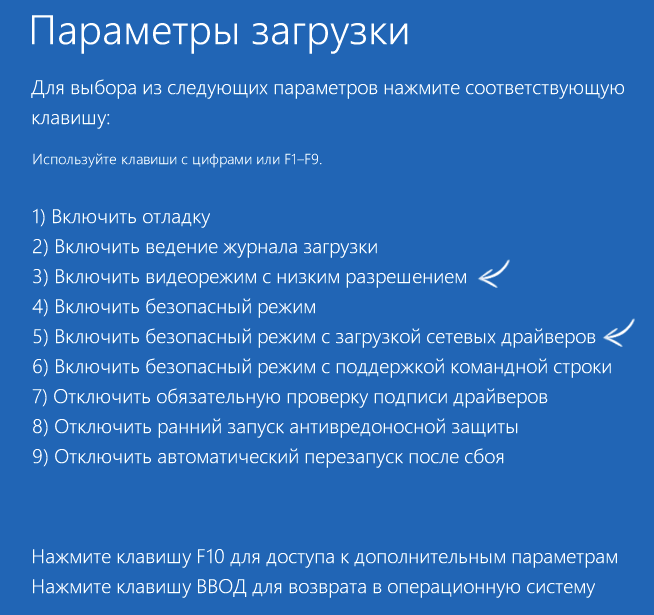
Компьютер перезагрузится и покажет вам особые варианты загрузки. Используя числовые клавиши 3 (F3) или 5 (F5) для того, чтобы запустить режим с низким разрешением экрана или безопасный режим с поддержкой сети. Загрузившись, вы можете либо попробовать запустить восстановление системы в панели управления, либо удалить имеющиеся драйвера видеокарты, после чего, перезапустив Windows 10 в обычном режиме (изображение должно появиться), установить их заново. (см. Установка драйверов NVidia для Windows 10 — для AMD Radeon шаги будут почти теми же самыми)
Если такой способ загрузить компьютер по какой-то причине не срабатывает, можно попробовать следующий вариант:
- Зайти в Windows 10 с паролем (так как это описывалось в начале инструкции).
- Нажать клавиши Win+X.
- 8 раз нажать вверх, а затем — Enter (откроется командная строка от имени администратора).
В командной строке введите (должна быть английская раскладка): bcdedit /set {default} safeboot network и нажмите Enter. После этого введите shutdown /r нажмите Enter, через 10-20 секунд (или после звукового оповещения)— еще раз Enter и подождите, пока компьютер не перезагрузится: он должен загрузиться в безопасном режиме, где можно будет удалить текущие драйвера видеокарты или запустить восстановление системы. (Для того, чтобы в дальнейшем вернуть обычную загрузку, в командной строке от имени администратора используйте команду bcdedit /deletevalue {default} safeboot )
Дополнительно: если у вас имеется загрузочная флешка с Windows 10 или диск восстановления, то вы можете воспользоваться ими: Восстановление Windows 10 (можно попробовать использовать точки восстановления, в крайнем случае — сброс системы).
Если проблема сохраняется и разобраться не получается, пишите (с подробностями о том, что, как и после каких действий произошло и происходит), правда не обещаю, что смогу дать решение.

Suddenly seeing nothing but a black screen and your mouse pointer? Don’t panic! This is a relatively common problem in Windows 10 and, while it’s very frustrating, it isn’t usually that hard to fix.
6 fixes for the Windows 10 black screen with mouse pointer problem
There are six possible solutions for this problem. You may not have to try them all – just work your way down the list until you find the fix that works for you.
- Remove battery & long-press power button (laptops only)
- Update your graphics drivers
- Disable fast startup
- Disable integrated graphics card
- Log in using a different user account
- Reset your PC
Fix 1: Remove battery & long-press power button (laptops only)
If you’re on a laptop:
1) Shut down your laptop.
2) Remove its battery.
3) While the battery is out, press and hold the power button for 60 seconds.
4) Put the battery back in and start your PC again.
If this doesn’t work (or you’re on a desktop PC), try Fix 2 below.
Fix 2: Update your graphics drivers
It’s quite likely that your black screen problem is caused by an outdated, corrupt or incorrect video driver. As updating your drivers is quite an easy task (and something you should do, anyway, for the general health of your computer), it should be one of the first fixes you try.
If you’re good with computers, and you’re confident playing around under the hood, you can update your drivers manually by visiting the manufacturer websites for all your devices and cards, finding the right drivers for your operating system and version of Windows, and manually downloading and installing them.
But if you’re not particularly good with computers, you don’t want to risk installing the wrong thing, or you just want to save a LOT of time, you can update your video driver (and all your other drivers) automatically with Driver Easy. It will automatically recognize your system and find the correct drivers for it. Here’s how:
1) Restart your computer in Safe Mode with Network.
2) Download and install Driver Easy.
3) Run Driver Easy and click Scan Now. Driver Easy will then scan your computer and detect any problem drivers.

4) Click the Update button next to a flagged graphics driver to automatically download and install the correct version of this driver (you can do this with the FREE version of Driver Easy).
Or click Update All to automatically download and install the correct version of all the drivers that are missing or out of date on your system (this requires the Pro version – you’ll be prompted to upgrade when you click Update All – the Pro version comes with a 30-day money-back guarantee).
e.g. Here’s a screenshot of the Intel HD Graphics 4400. Your results will show your graphics card.

Fix 3: Disable fast startup
Disabling Fast Startup may resolve the black screen problem. Here’s how to do it:
1) Restart your computer in Safe Mode.
2) Press Control Panel in the search box at the bottom corner of the desktop, and click Control Panel in the pop-up menu.

2) View by “Small icons” and click Power Options.

3) Click Choose what the power button does.

4) Click Change settings that are currently unavailable.

5) Under “Shutdown settings”, uncheck Turn on fast startup (recommended) then click Save changes .

Fix 4: Disable integrated graphics card
If you have a separate graphics card, your computer may think it has a dual monitor, which can cause the black screen + mouse pointer problem. In this case, disabling the integrated graphics card may fix the problem.
1) Restart your computer in Safe Mode.
2) On your keyboard, press the Windows logo key and R at the same time to invoke the run box.
3) Type devmgmt.msc and click OK.

4) Under “Display adapters”, you’ll see more than one graphics card. Right-click on the integrated graphics card (usually an Intel or AMD graphics card). Click Disable.
5) Restart your PC.
If you’re not sure which one is the integrated graphics one, disable one by one and see if the problem is resolved.
Fix 5: Log in using a different user account
The black screen problem can also be caused by corrupted Windows user profile. If you can log in to Windows with a different user account, and use it without any problems, a corrupted user profile may be the cause. You can then replace the folder of the corrupted user profile with the folder of the working user profile. Here’s how:
1) Restart your computer in Safe Mode.
2) Login with the working user account.
3) Navigate to C:\Users\{working-user-profile-name}\AppData\Local\Microsoft\Windows\Caches.
4) Copy the folder “Caches”.
5) Login with the corrupted user account.
6) Navigate to C:\Users\{broken-user-profile-name}\AppData\Local\Microsoft\Windows\Caches.
7) Replace the folder with the folder from the working user file.
If you don’t have an existing working user account, you can create a new account. Here’s how:
1) Ensure your Windows user account is an administrator. (If it’s not, you can activate the built-in administrator account in Windows and use it to login to Windows. See the instructions further down this page for how to do this.)
2) Type “settings” in the search box and select Settings.
3) Click Accounts.

4) Click Other people in the left pane and click Add someone else to this PC.

5) Follow the on-screen instructions to create a new user account.
6) Log in to this account and check to see if the black screen problem persists.
Activate the built-in Windows administrator
If, as discussed above, your Windows account is not an administrator account, you can activate the built-in Windows administrator, then log in to that account to create a new user. Here’s how to activate the built-in Windows administrator:
1) Open Command Prompt as administrator: type cmd in the search box. Right click Command Prompt and select Run as administrator.
2) Type net user administrator /active:yes and press the Enter key on your keyboard.

3) Restart your computer and you’ll be able to log in to Windows with the administrator account.
4) Create and test a new user account as described above.
Fix 6: Reset your PC
The final solution you can try is to reset your PC. This will reinstall Windows entirely. If you’re not comfortable with resetting your PC, we recommend you contact your PC manufacturer for further assistance.
1) Restart your computer in Safe Mode.
2) Type settings in the search box at the bottom left corner of the desktop, then click Settings in the menu that displays.

3) Click Update & security.

4) Click Recovery.

4) Under ‘Reset this PC’, click Get started. Then follow the on-screen instructions to reset your PC.

Hopefully one of these fixes has resolved your Windows 10 black screen with cursor error. If you have any questions, please comment below as we’re happy to hear of any suggestions and ideas.

